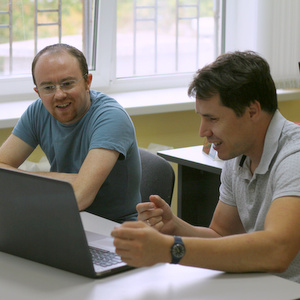Interuniversity integration is carried out within the grants of the Russian Foundation for Basic Research (RFBR) and the Royal Society of London. Scientists of Samara and the UK are developing tools for analysis and computer design of innovative microporous materials. This is a new class of materials —metal-organic coordination polymers (MOCP). These are highly porous polymers of organic molecules and metal ions bound into a three-dimensional structure. The resulting coordination grid has a record porosity. One gram of such substance has a pore surface commensurate with a football field.
The project “Theory and Methods of Combined Topological and Quantum Chemical Prediction of Anisotropy of Mechanical Properties of Microporous Wireframe Materials”, funded by the RFBR grant, is implemented due to the close cooperation of senior researcher of Inter-University Research Center for Theoretical Materials Science of Samara University Evgeniy Aleksandrov and Dr. Matthew Addicoat (Nottingham Trent University , the United Kingdom). As a result of the international collaboration, the scientists are intending to develop new approaches to modeling of mechanical properties of microporous compounds by the example of metal-organic and covalent organic frameworks.
On the basis of the Center for Theoretical Materials Science, ToposPro software is being created, which enables to search for MOCP with predicted predetermined properties. "Those ambitious tasks that we face — the modeling of new materials with predetermined properties, can be performed only in cooperation with Samara National Research University, because a unique ToposPro software, which has no analogues in the world is developed here. — emphasizes Matthew Addicoat. — Within the framework of the project we want to combine the advantages of our software products: Samara University analytical ToposPro complex and my AuToGraFS program for solving the problem of designing new flexible metal-organic framework polymers".
The scientists received the first results, exchanged data as well as opinions on their further development. “At the moment we have created a Database of MOCP building blocks, synthons, cavities. Building blocks are organic linkers or bundles and secondary building units containing metal cations. These are cations that glue the linkers into a common structure. The frameworks are assembled by the building blocks, as well as architectural structures are made of the bricks. We have also formed the Base of geometric-topological properties of microporous metal-organic and covalent organic frameworks. This is the base of the variants of the assembly. The sequence of assembly can be different, their variety is very large. In the future, we are planning to select the most promising compounds from these bases.” — summed up Evgeniy Aleksandrov.
According to scientific standards metal-organic frame polymers have been discovered relatively recently — at the turn of 1990s and 2000s. However, it is already clear now that new materials, (which can be constructed and subsequently synthesized with certain characteristics, selected especially for the necessary conditions and tasks), provide wide range of opportunities for industry. These include, for example, membranes for the separation of gases, catalysts, sensors, nanocontainers for storage of gases, drugs, toxic and unstable substances.
